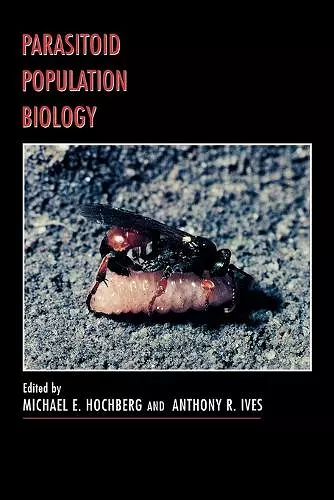Parasitoid Population Biology
Michael E Hochberg editor Anthony R Ives editor
Format:Paperback
Publisher:Princeton University Press
Currently unavailable, and unfortunately no date known when it will be back

I have often been asked what are the interesting questions to study in host-parasitoid biology, and this volume suggests a large number in a variety of different fields. In so doing, it will interest a wider audience than simply scientists working specifically in host-parasitoid biology. For both, however, the book will stimulate new research ideas. By looking forward, as well as reviewing the past, Parasitoid Population Biology makes for a novel, interesting, and timely addition to the field. -- Howard Wilson, Biology Department, Imperial College The underlying rationale for Parasitoid Population Biology--the need to question our current understanding of parasitoid population biology--is a laudable one. The editors and contributors are recognized experts at the international level, and are at the cutting edge of parasitoid population biology research. As such, they are well placed to assess the current state of the subject. I thoroughly enjoyed reading the book, and I expect to consult it frequently in my own research and teaching. -- Mark Jervis, Cardiff University Hochberg and Ives have brought together a group of leading researchers to remind populations biologists of every stripe of the unparalleled opportunity that parasitoids offer for studying the integration of ecology and evolution. In no other animal group is resource acquisition (i.e., foraging for hosts) so tightly linked to reproduction (i.e., oviposition into those hosts). As the chapters of this book convincingly demonstrate, this linkage between foraging and reproducing in parasitoids leads to tractable theories that connect life history variations to population regulation and community structure in both space and time. Although parasitoids are not without difficulties as experimental subjects, several authors show the wealth of empirical information already available as well as point to forthcoming innovations that will make parasitoid study even more important in the near future. This book tells us where we stand vis a vis parasitoids, but more importantly, it shows us where we can go. -- Arthur E. Weis, University of California, Irvine
Presents the ideas of seventeen international specialists, providing the reader not only with an overview, but also with discussions of the salient questions pertaining to the field and prescriptions for avenues of research. This book is divided into three main sections: population dynamics, population diversity, and population applications.Extraordinary in the diversity of their lifestyles, insect parasitoids have become extremely important study organisms in the field of population biology, and they are the most frequently used agents in the biological control of insect pests. This book presents the ideas of seventeen international specialists, providing the reader not only with an overview but also with lively discussions of the most salient questions pertaining to the field today and prescriptions for avenues of future research. After a general introduction, the book divides into three main sections: population dynamics, population diversity, and population applications. The first section covers gaps in our knowledge in parasitoid behavior, parasitoid persistence, and how space and landscape affect dynamics. The contributions on population diversity consider how evolution has molded parasitoid populations and communities. The final section calls for novel approaches toward resolving the enigma of success in biological control and questions why parasitoids have been largely neglected in conservation biology. Parasitoid Population Biology will likely be an important influence on research well into the twenty-first century and will provoke discussion amongst parasitoid biologists and population biologists. In addition to the editors, the contributors are Carlos Bernstein, Jacques Brodeur, Jerome Casas, H.C.J. Godfray, Susan Harrison, Alan Hastings, Bradford A. Hawkins, George E. Heimpel, Marcel Holyoak, Nick Mills, Bernard D. Roitberg, Jens Roland, Michael R. Strand, Teja Tscharntke, and Minus van Baalen.
"An excellent edited volume that provides a useful synthesis of knowledge in the field and clear guidance for future research goals. The book is not an exhaustive review of the field, but it is more readable because it is focused on a limited number of specific problems... [It] is concise and coherent enough so that readers will want to read the entire volume."--Timothy P. Craig, Ecology "A useful and interesting book."--Donald H. Feener, Jr.,The Quarterly Review of Biology
ISBN: 9780691049823
Dimensions: unknown
Weight: 510g
384 pages